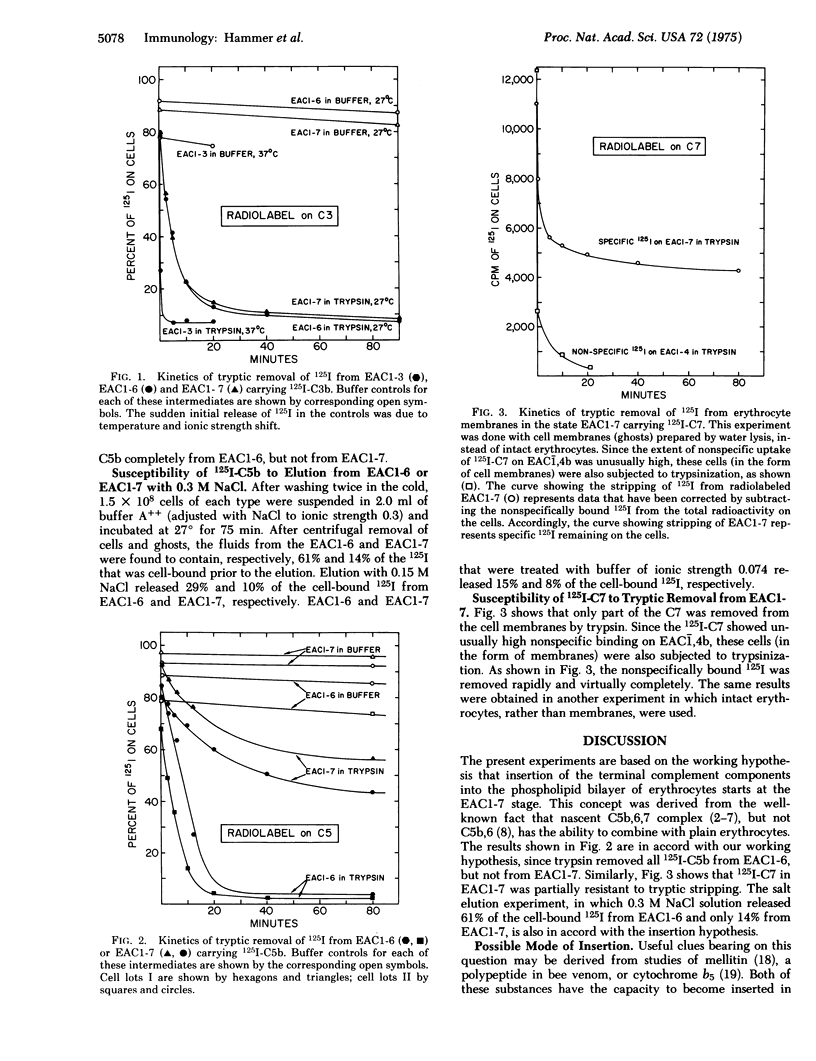Abstract
The doughnut hypothesis of cytolysis by complement [Mayer, M. M. (1972) Proc. Nat. Acad. Sci. USA 69, 2954-2958] describes an annular structure made up of C5b-9 (complement factors C5b, C6, C7, C8, and C9) which becomes inserted in the lipid bilayer of the cell membrane, thus creating a hole. We now present initial explorations of this hypothesis. EAC1-6 and EAC1-7 (sheep erythrocytes carrying rabbit antibody and complement factors C1 through C6 or C1 through C7, respectively), prepared with either 125I-C3 or 125I-C5 were incubated with trypsin and the release of bound 125I was measured. In the case of 125I-C3, all of the radioactivity was released by trypsin from both intermediates. With 125I-C5, trypsin released all of the 125I from EAC1-6, but only 40-55% from EAC1-7. Possible reasons for resistance of the C5b subunit in EAC1-7 to tryptic digestion are discussed; in terms of the doughnut hypothesis it would be due to shielding by lipid molecules as a consequence of insertion into the lipid bilayer. In accord with this interpretation we have also found that C5b in EAC1-7, but not in EAC1-6, resists elution by 0.3 M NaC1. Similarly, we have found that 125I-C7 in EAC1-7 resists stripping by trypsin. Hence, we now propose the hypothesis that hydrophobic polypeptide chains from the C5b and the C7 subunits of C5b,6,7 complex become inserted in the phospholipid bilayer and that subsequent reactions with C8 and C9 open a channel across the membrane.
Full text
PDF




Selected References
These references are in PubMed. This may not be the complete list of references from this article.
- Borsos T., Rapp H. J. Immune hemolysis: a simplified method for the preparation of EAC'4 with guinea pig or with human complement. J Immunol. 1967 Aug;99(2):263–268. [PubMed] [Google Scholar]
- Cook C. T., Shin H. S., Mayer M. M., Laudenslayer K. A. The fifth component of the guinea pig complement system. I. Purification and characterization. J Immunol. 1971 Feb;106(2):467–472. [PubMed] [Google Scholar]
- Goldlust M. B., Shin H. S., Hammer C. H., Mayer M. M. Studies of complement complex C5b,6 eluted from--EAC-6: reaction of C5b,6 with EAC4b,3b and evidence on the role of C2a and C3b in the activation of C5. J Immunol. 1974 Sep;113(3):998–1007. [PubMed] [Google Scholar]
- Goldman J. N. Reactions of nascent C567 (reactive lysis). Transplant Proc. 1974 Mar;6(1):21–25. [PubMed] [Google Scholar]
- Goldman J. N., Ruddy S., Austen K. F. Reaction mechanisms of nascent C567 (reactive lysis). I. Reaction characteristics for production of EC567 and lysis by C8 and C9. J Immunol. 1972 Aug;109(2):353–359. [PubMed] [Google Scholar]
- Götze O., Müller-Eberhard H. J. Lysis of erythrocytes by complement in the absence of antibody. J Exp Med. 1970 Nov;132(5):898–915. doi: 10.1084/jem.132.5.898. [DOI] [PMC free article] [PubMed] [Google Scholar]
- Kolb W. P., Haxby J. A., Arroyave C. M., Müller-Eberhard H. J. Molecular analysis of the membrane attack mechanism of complement. J Exp Med. 1972 Mar 1;135(3):549–566. doi: 10.1084/jem.135.3.549. [DOI] [PMC free article] [PubMed] [Google Scholar]
- Kolb W. P., Muller-Eberhard H. J. The membrane attack mechanism of complement. Isolation and subunit composition of the C5b-9 complex. J Exp Med. 1975 Apr 1;141(4):724–735. [PMC free article] [PubMed] [Google Scholar]
- Kolb W. P., Müller-Eberhard H. J. The membrane attack mechanism of complement. Verification of a stable C5-9 complex in free solution. J Exp Med. 1973 Aug 1;138(2):438–451. doi: 10.1084/jem.138.2.438. [DOI] [PMC free article] [PubMed] [Google Scholar]
- Lachmann P. J., Thompson R. A. Reactive lysis: the complement-mediated lysis of unsensitized cells. II. The characterization of activated reactor as C56 and the participation of C8 and C9. J Exp Med. 1970 Apr 1;131(4):643–657. doi: 10.1084/jem.131.4.643. [DOI] [PMC free article] [PubMed] [Google Scholar]
- Marchalonis J. J. An enzymic method for the trace iodination of immunoglobulins and other proteins. Biochem J. 1969 Jun;113(2):299–305. doi: 10.1042/bj1130299. [DOI] [PMC free article] [PubMed] [Google Scholar]
- Mayer M. M. Mechanism of cytolysis by complement. Proc Natl Acad Sci U S A. 1972 Oct;69(10):2954–2958. doi: 10.1073/pnas.69.10.2954. [DOI] [PMC free article] [PubMed] [Google Scholar]
- Mayer M. M., Miller J. A., Shin H. S. A specific method for purification of the second component of guinea pig complement and a chemical evaluation of the one-hit theory. J Immunol. 1970 Aug;105(2):327–341. [PubMed] [Google Scholar]
- McLeod B., Baker P., Gewurz H. Studies on the inhibition of C56 initiated lysis (reactive lysis). I. Description of the phenomenon and methods of assay. Immunology. 1974 Jun;26(6):1145–1157. [PMC free article] [PubMed] [Google Scholar]
- Nelson R. A., Jr, Jensen J., Gigli I., Tamura N. Methods for the separation, purification and measurement of nine components of hemolytic complement in guinea-pig serum. Immunochemistry. 1966 Mar;3(2):111–135. doi: 10.1016/0019-2791(66)90292-8. [DOI] [PubMed] [Google Scholar]
- Nilsson U. R., Mandle R. J., Jr, McConnell-Mapes J. A. Human C3 and C5: subunit structure and modifications by trypsin and C42-C423. J Immunol. 1975 Feb;114(2 Pt 2):815–822. [PubMed] [Google Scholar]
- Robinson N. C., Tanford C. The binding of deoxycholate, Triton X-100, sodium dodecyl sulfate, and phosphatidylcholine vesicles to cytochrome b5. Biochemistry. 1975 Jan 28;14(2):369–378. doi: 10.1021/bi00673a025. [DOI] [PubMed] [Google Scholar]
- Shin H. S., Mayer M. M. The third component of the guinea pig complement system. I. Purification and characterization. Biochemistry. 1968 Aug;7(8):2991–2996. doi: 10.1021/bi00848a040. [DOI] [PubMed] [Google Scholar]
- Stolfi R. L. Immune lytic transformation: a state of irreversible damage generated as a result of the reaction of the eighth component in the guinea pig complement system. J Immunol. 1968 Jan;100(1):46–54. [PubMed] [Google Scholar]
- Tamura N., Shimada A. The ninth component of guinea-pig complement. Isolation and identification as an alpha 2-globulin. Immunology. 1971 Mar;20(3):415–425. [PMC free article] [PubMed] [Google Scholar]
- Thompson R. A., Lachmann P. J. Reactive lysis: the complement-mediated lysis of unsensitized cells. I. The characterization of the indicator factor and its identification as C7. J Exp Med. 1970 Apr 1;131(4):629–641. doi: 10.1084/jem.131.4.629. [DOI] [PMC free article] [PubMed] [Google Scholar]
- Williams J. C., Bell R. M. Membrane matrix disruption by melittin. Biochim Biophys Acta. 1972 Nov 2;288(2):255–262. doi: 10.1016/0005-2736(72)90246-5. [DOI] [PubMed] [Google Scholar]


